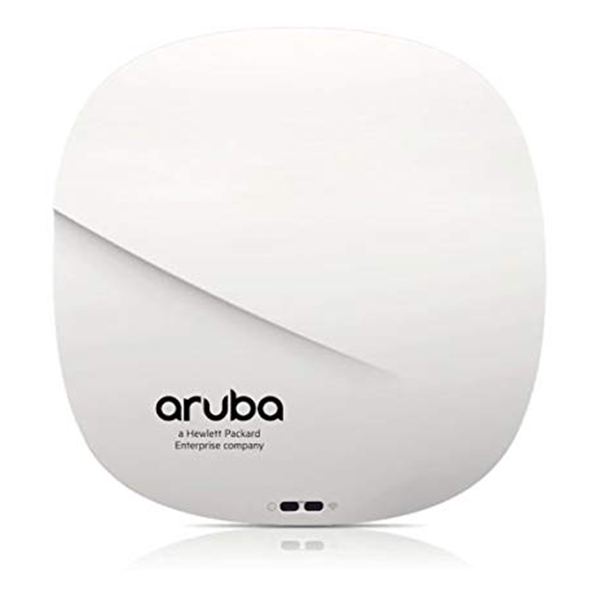Thông số kỹ thuật Aruba IAP-315-RW
| TECHNICAL SPECIFICATIONS | |
| AP type | Indoor, dual radio, 5 GHz 802.11ac 4×4 MIMO and 2.4 GHz 802.11n 2×2 MIMO |
| 5GHz radio | Four spatial stream Single User (SU) MIMO for up to 1,733 Mbps wireless data rate to individual 4×4 VHT80 or 2×2 VHT160 client devices |
| 2.4GHz radio | Two spatial stream Single User (SU) MIMO for up to 300 Mbps wireless data rate to individual 2×2 HT40 client devices |
| Maximum number of associated client devices | Up to 256 associated client devices per radio |
| Maximum number of BSSIDs | 16 BSSIDs per radio |
| Supported frequency bands (country-specific restrictions apply) | – 2.400 to 2.4835 GHz – 5.150 to 5.250 GHz – 5.250 to 5.350 GHz – 5.470 to 5.725 GHz – 5.725 to 5.850 GHz |
| Dynamic frequency selection (DFS) optimizes the use of available RF spectrum | |
| Supported radio technologies | – 802.11b: Direct-sequence spread-spectrum (DSSS) – 802.11a/g/n/ac: Orthogonal frequency-division multiplexing (OFDM) |
| Supported modulation types | – 802.11b: BPSK, QPSK, CCK – 802.11a/g/n/ac: BPSK, QPSK, 16-QAM, 64-QAM, 256-QAM |
| 802.11n high-throughput (HT) support | HT20/40 |
| 802.11ac very high throughput (VHT) support: | VHT20/40/80/160 |
| Supported data rates (Mbps): | -802.11b: 1, 2, 5.5, 11 – 802.11a/g: 6, 9, 12, 18, 24, 36, 48, 54 – 802.11n (2.4GHz): 6.5 to 300 (MCS0 to MCS15) – 802.11n (5GHz): 6.5 to 600 (MCS0 to MCS31) – 802.11ac: 6.5 to 1,733 (MCS0 to MCS9, NSS = 1 to 4 for VHT20/40/80, NSS = 1 to 2 for VHT160) |
| 802.11n/ac packet aggregation: | A-MPDU, A-MSDU |
| Transmit power | Configurable in increments of 0.5 dBm |
| Maximum (aggregate, conducted total) transmit power (limited by local regulatory requirements): | – 2.4 GHz band: +18 dBm per chain , +21dBm aggregate (2×2) – 5 GHz band: +18 dBm per chain , +24dBm aggregate (4×4) |
| WI-FI ANTENNAS | |
| Antenna | Four integrated dual-band downtilt omni-directional antennas for 4×4 MIMO with peak antenna gain of 3.6dBi in 2.4 GHz and 6.0dBi in 5 GHz. Built-in antennas are optimized for horizontal ceiling mounted orientation of the AP. The downtilt angle for maximum gain is roughly 30 degrees. – Combining the patterns of each of the antennas of the MIMO radios, the peak gain of the effective per-antenna pattern is 3.1dBi in 2.4 GHz and 3.8dBi in 5 GHz |
| OTHER INTERFACES | |
| Uplink (E0): Smart Rate Ethernet wired network port (RJ45) | • Auto-sensing link speed (100/1000/2500BASE-T) and MDI/MDX • 802.3az Energy Efficient Ethernet (EEE) |
| USB 2.0 host interface | Type A connector |
| Bluetooth Low Energy BLE5 radio | – Up to 4dBm transmit power (class 2) and -91dBm receive sensitivity – Integrated antenna with roughly 30 degrees downtilt and peak gain of 1.5dBi |
| Visual indictors (two multi-color LEDs): | For system and radio status |
| Reset button: | Factory reset (during device power up) |
| Serial console interface | (proprietary; optional adapter cable available |
| FLEXIBLE OPERATION AND MANAGEMENT | |
| Controller-less (Instant) mode | In controller-less mode, one AP serves as a virtual controller for the entire network |
| Remote AP or IAP-VPN mode | For both cloud and on-premises deployments, each AP can establish secure overlay VPN tunnels to a VPN Concentrator (VPNC). Aruba Central-managed SD-WAN Gateways and onpremises Mobility Controllers both support VPNC functionality |
| Mobility Controller mode | For optimized network performance, roaming and security, APs tunnel all traffic to a mobility controller for centrally managed traffic forwarding and segmentation, data encryption, and policy enforcement |
| Management options | Available management solutions include Aruba Central (cloud-managed) or Aruba AirWave – a multi-vendor on-premises management solution. |
| POWER SOURCES AND POWER CONSUMPTION | |
| Power Sources: The AP supports direct DC power and Power over Ethernet | • The AP supports direct DC power and Power over Ethernet • When both DC and POE power sources are available, DC power takes priority over POE • Power sources are sold separately. • Direct DC source: 12Vdc nominal, +/- 5% • When using IPM, the AP may enter power-save mode with reduced functionality when powered by an 802.3af PoE source (see details on Intelligent Power Monitoring elsewhere in this datasheet) • Without IPM, the USB port is disabled and transmit power of the 2.4 GHz radio chains are reduced by 3dB to 15dBm max when the AP is powered by an 802.3af PoE source |
| Maximum (worst-case) power consumption (without USB or PSE / max): | • DC powered: 12.7 • POE powered (802.3at): 14.4W • POE powered (802.3af): 13.6 |
| Maximum (worst-case) power consumption in idle mode | 6.4W (PoE) or 5.9W (DC) |
| MECHANICAL SPECIFICATIONS | |
| Dimensions/weight (unit, excluding mount accessories): | – 182mm (W) x 180mm (D) x 48mm (H) – 650g/23oz |
| Dimensions/weight (shipping): | – 223mm (W) x 218mm (D) x 55mm (H) – 850g/30oz |
| ENVIRONMENTAL SPECIFICATIONS | |
| Operating conditions | – Temperature: 0° C to +50° C (+32° F to +122° F) – Humidity: 5% to 93% non-condensing |
| Storage and transportation conditions | – Temperature: -40° C to +70° C (-40° F to +158° F) |
| RELIABILITY | |
| Mean Time Between Failure (MTBF): | MTBF: 916,373 hrs (105yrs) at +25C operating temperature |
| MINIMUM OPERATING SYSTEM SOFTWARE VERSIONS | |
| ArubaOS | 6.5.0.0, 8.0.1.0 |
| Minimum Software Release | 4.3.0.0 |
Chi tiết specs xem tại đây




Đánh giá